
Churches and Cathedrals of Manhattan, New York City - 3
Personal notes and information gleaned following a visit October 2003, and features only the churches which I discovered during my seven days in New York. The churches face in all sorts of directions, the descriptions that follow therefore have ritual directions which assumes the high altar is at the east end of the building. The churches are all Roman Catholic, unless otherwise mentioned, and are featured in the order I visited them.
Our Saviour (Park Avenue, E.38th St)
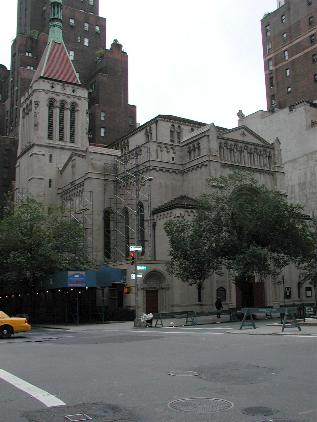 |
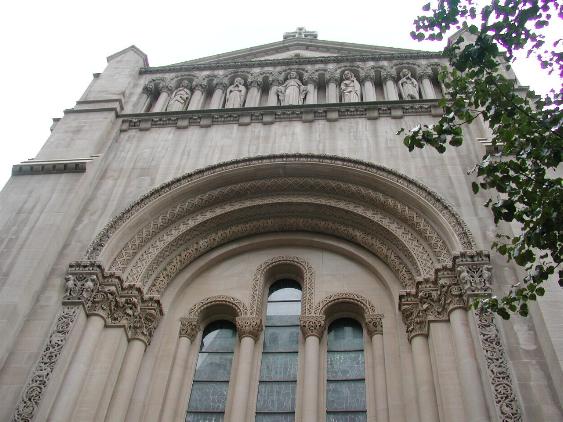 |
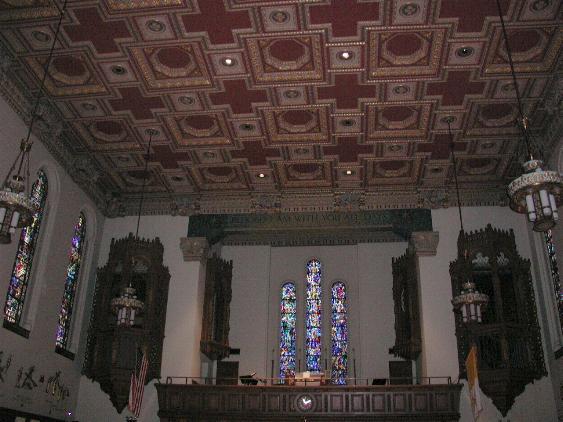 |
On Park Avenue to the south of Grand Central
Station stands a church which I was surprised to discover
was not even 50 years old. The date is 1957-59 and the
architect Paul C. Reilly. In style church is an amalgam
of French Gothic, Romanesque and Moorish architecture. It
has a tower at the NE angle which houses a cooling tower
for the air conditioning (this was New York's first
purpose-built air-conditioned church). On top of the
church proper is the rectory, below it the parish hall. The entrance vestibule has some of the best woodcarving I have seen and it is told that several craftsmen were brought out of retirement to create this work under the direction of Henry J Pizzutello. The interior of the church is a large rectangular space with a "Cosmati" mosaic and marble floor and a panelled ceiling. Transeptal bays in the centre of the north and south sides, narrower east and west bays for the sanctuary and entrance respectfully. Bronze baldichino, pulpit and reredos.
I found the church open. |
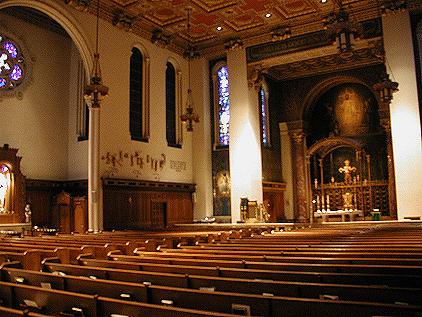 |
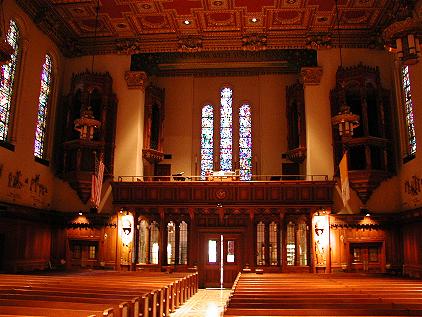 |
Transfiguration (Episcopal) (1. E29th St) - aka "THE LITTLE CHURCH AROUND THE CORNER"
| A most confusing jumble of spaces and features, a long low and internally rather dark building, with a Chinese-looking lychgate, two towers and basically an L-shaped plan. The oldest parts of the church date from 1849, by an unknown architect. The west tower is the principle entrance, and the chapels to the left as you enter were originally the parish schoolrooms. This area reached its current appearance in 1926 and is divided from the main church by two screens (with organ above) as a narthex. To the east is the nave and south aisle with little four-bayed arcade of wood. The south transept was added in 1852 and extended in the 1860s. The chancel was rebuilt and enlarged by F.C.Withers 1880-81 (who also designed the Guildhall and Rectory of 1861 and the Lychgate in 1896). In the angle of south aisle and south transept was added the strangely octagonal St Joseph's chapel with an apse facing to the SW and a second tower like upper stage. | 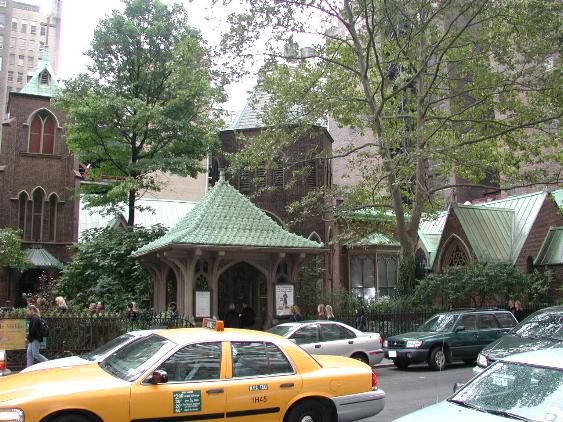 |
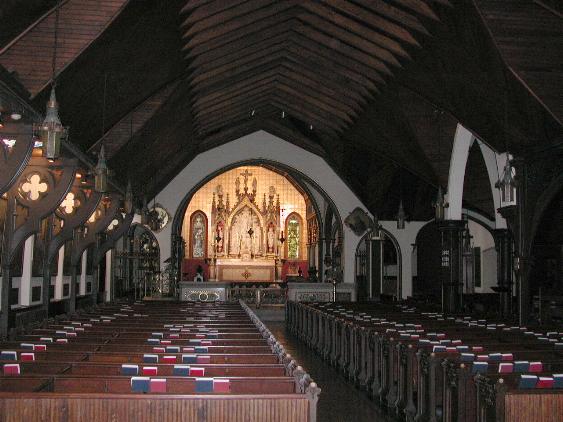 |
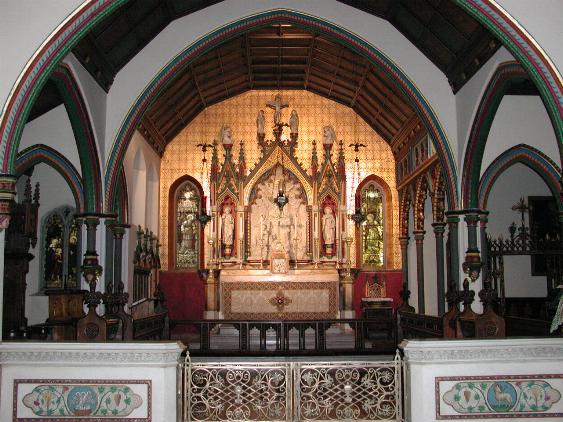 |
Yet despite this confusion and collision of parts, the church holds together with a degree of charm and attraction, which I did not feel in any other church on this visit. It is theatrical, yet small and intimate like a stage and audience would feel. It has chapels off in the wings, and a number of amusing and unique features. Just look at the brackets which support the roof on the north side of the nave and the contrasting thinness of the pillars on the opposite side. Then there is the curiously sited organ (below, left) and the forest of pillars when viewed alongside the organ (below, right). The church is dark, so much so that dormers were inserted; and in New York tradition these too are filled with stained glass. The window by the pulpit is however worthy of inspection, as here is perhaps the oldest stained glass of any church in the USA, aa C14 figure of St Faith (Ste Foi) from a Belgian church destroyed in the Napoleonic wars.
The church was open when I called, and usually is daily 0900-1700 except when services are taking place.
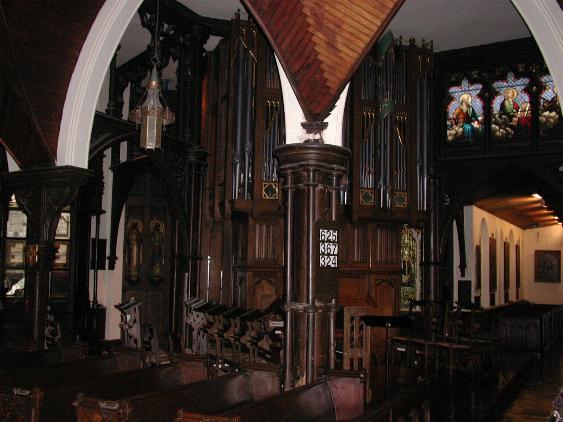 |
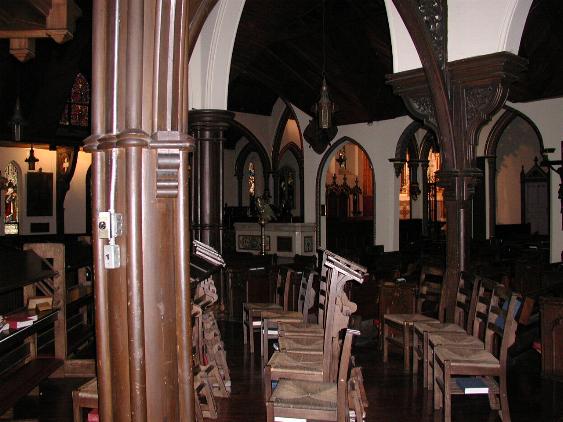 |
For more on the church history and its theatrical connections, and nickname, click the button below.
Marble Collegiate Reformed Church (Dutch Reformed) (5th Avenue, W29th St)
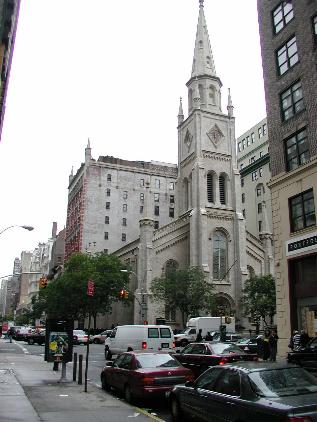 |
The church dates from 1851-54, although the
congregation is the oldest denomination in the city, its
origins going back to 1628. It is surrounded by an iron
fence, to keep out stray farm animals as when the church
was built Fifth Avenue was no more than a dusty country
road! The architect was Samuel A.Warner and the church is
so named as it is built from smooth blocks of white
marble. The style is a complete mix of Romanesque, Gothic
and Classical forms. The church is not usually open, but application to the offices along W29th St got us inside. Here is a wide open rectangle with galleries on three sides and a slight recessed central bay in the fourth (west) side which is flanked by organ pipes, the main organ is on the east gallery. The church is famous for two Tiffany windows in the south wall but my eyes were taken by the uncredited windows in the north wall which had a superb translucancy, one of which is captured in one of my few successful pictures on this visit of a stained glass window! Thanks to Don Piper at the Marble church who tells me that this window pictured below is entitled "The Stilling of the Storm" and is the church's newest window dedicated on 1st June 2003. It is by British artist Debora Coombs, hand-painted in her studio in Vermont. |
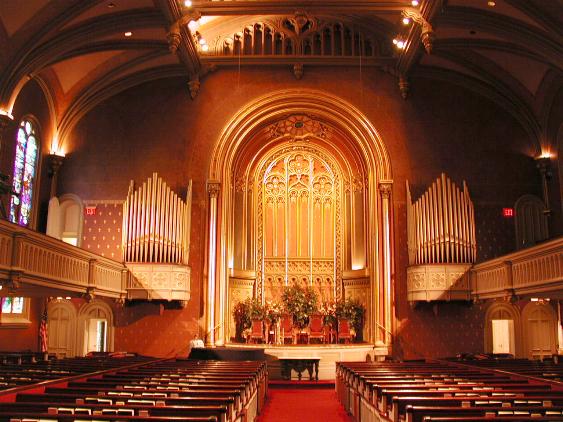 |
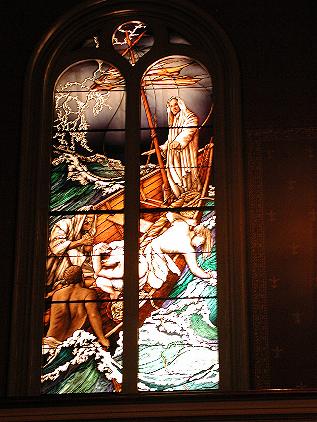 |
<BACK> <MANHATTAN INDEX> <NEXT>
page updated 26th March 2005